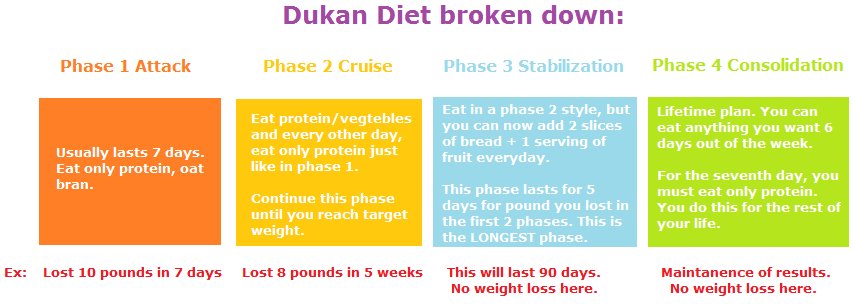The Four Phases of the Dukan Diet
The Dukan diet is a low carb diet which has four phases, each of which has a specific set of rules.
This diet consists of many do’s and don’ts and it promises sustainable weight loss if the rules are faithfully adhered to.
The Dukan diet is known to have worked successfully for Kate Middleton and Jennifer Lopez, which largely explains is why it is a well-known and popular diet.
One thing is certain. If you follow this diet you will lose weight, even within a couple of days.
The question asked by many health practitioners and health conscious dieters is whether or not this diet is safe and sustainable. Some say yes, others say no.
The reason for the conjecture is that this diet allows you to load your body with as many low fat protein foods as you desire, while excluding other food types for specified periods. The risk in doing so is that your body may not receive the necessary nutrients obtained from these other food sources.
So is it safe and sustainable?
As there are strong claims from both sides here is some information about the four phases of the Dukan diet to help you decide if this program is suitable for you.
• The First Phase: Attack
The first phase is called the Attack Phase which allows an individual to eat as many low-fat, protein-rich foods as they want. This may include lean meats and vegetable protein sources such as seitan and tofu.
You are allowed the use of different herbs and spices for spicing up the monotony.
Drink water as much as you like but steer clear of any calorie-containing drinks, including diet sodas.
This phase may last up to ten days. The length of time that many Dukan dieters have spent in this phase is usually five days, but this is able to be varied depending on your desired amount of weight loss.
• The Second Phase: Cruise
The second phase is called the Cruise phase, which ends when you have obtained your goal weight. This is when you can include all the recommended vegetables while avoiding the starchy ones, so no potatoes, among others.
In this phase you can alternate your pure protein consumption with protein plus allowed vegetables.
Some people consume pure protein for five days and then protein plus vegetables for the next five days. You will continue with this phase until you reach your desired weight.
• The Third Phase: Consolidation
The third phase of the Dukan Diet is called the Consolidation Phase.
This phase is specifically designed to overcome the tendency to regain the weight which has been lost in the first two phases of the program.
The focus is on training your mind and body to accept your new weight and body as its normal form.
For every pound you have lost in phase one and two, you have to stay in this phase for five days. For example, if you lost 20 pounds from your starting weight, you would have to stay in this phase for 100 days.
In the consolidation phase, you mostly continue following the rules in the second phase. The only difference is that you can now slowly add specified foods to your diet.
For example, you can add one serving of fruit every day, except for those that are high in calorie content such as bananas, dried fruit, cherries and grapes.
• The Fourth Phase: Permanent Stabilization

This final phase is the lifetime or maintenance phase and intended for maintaining your desired weight.
It allows you to eat most foods you want for six days in every week, but gives guidelines for sensible limits and foods to avoid as well as encouraging regular exercise.
It involves self-observation and monitoring to avoid back-sliding into bad habits and weight gain, with advice on how to do so.
One specific requirement is to add three tablespoons of oat bran to your daily diet.
On the same pre-determined day of every week, you are allowed to eat only protein foods as you did in the Attack Phase.
The Dukan diet is often thought of as being similar to the Atkins diet, but the two diets are very different in many ways.
[PC-Popup id=2]
